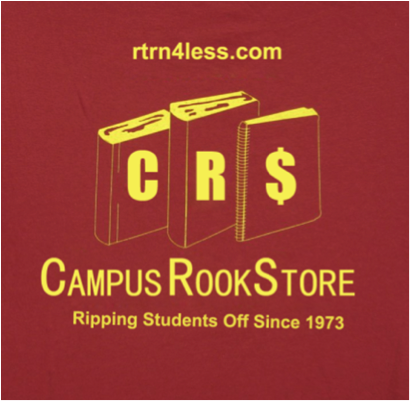challenges/part_one
I'd like to close this description of the project and its benefits with a discussion of some of the dangers it poses, and a look ahead to emergent challenges. First, I do not . . .
Challenges - Digital Rights Millenium Act
challenges/part_two
These challenges, however, pale in the face of the greatest challenge to culture jamming projects: the 1998 Digital Millennium Copyright Act (DMCA), which mandates criminal . . .
Challenges - Irony of Rebellion
challgenges/part_one
I'd like to close this description of the project and its benefits with a discussion of some of the dangers it poses, and a look ahead to emergent challenges. First, and most importantly, I do not suggest that culture jamming should be broadly instituted in a first-year composition curriculum (and in fact I feel that great care must be taken in using the assignment at all). Regarding critical media literacy, Kellner (2000) warns, "it would be a mistake to attempt to institute a top-down program . . . imposed from above on teachers, with fixed texts, curricula, and prescribed materials" (p. 206), and this same danger is even more acute with culture jamming. Not only do different teachers have different pedagogical concerns and different interests, but more importantly there is a real risk that the university itself may stifle the empowering function of the culture jam if it were to be mechanically imposed. The danger amounts to a reproduction of the same kinds of power structures that culture jamming seeks to subvert. There is, however, opportunity here for real and critical resistance provided individual teachers remain flexible about what constitutes culture jamming. Jamming the jamming assignment itself, for instance, could be productively and legitimately seen as effective, however much it targets the teacher and the classroom. Students should be encouraged in, rather than dissuaded from, thinking along these lines, and a prescribed program mandated from above makes this unlikely.
Second, there is something ironic that smacks of the hypocritical in requiring students to actively resist authority and making their success in a course contingent upon that resistance. This potential hypocrisy poses a grave danger to the critical efficacy of this kind of project and its radical democratic goals. On the one hand the project asks students to take on the role of agent to effect change, but on the other it imposes this role upon them, potentially recreating the hegemonic institutions it seeks to subvert and co-opting the spirit of the culture jam in the service of education. In order to avoid undermining the democratic goals, culture jamming must be undertaken thoughtfully, with sensitivity, and above all with the larger goals firmly in mind. It is not only the marketing practices of large corporations that participate in the distortion of information, other institutions such as the federal and local governments, and even colleges and universities do as well, as they market their products for their consumers, our students, sometimes in more insidious and thus more dangerous ways, and potential culture jammers must keep this larger context before them at all times.
There is a third danger involved in the production of culture jams that is more easily resolved, but no less important to mention, and that is the use of proprietary software to appropriate and edit images used in the act of jamming. Many will see the use of software like Microsoft's Word and Paint programs, like Adobe's Photoshop, and Apple's iWeb as embodiments of the kind of corporate interests that jamming tries to subvert and will claim that, whatever its ends, using this software as a means to those ends is hypocritical and undermines the project itself. Others would say that access to this software represents the kind of class distinction that culture jamming is dedicated to overturning. However much I may sympathize with these line of argument, I do not think they are sound. First, I do not believe it is hypocritical to use the tools of the oppressor against him. In fact there is a long tradition of this and there is a certain poetic justice that pleases the culture jammer in me. Second, there exists a wide range of free and open-source software packages that perform the same functions as those proprietary packages I mentioned, open-source programs such as GIMP, Photoscape and many others. In fact, for whatever application, it is likely there is an open-source alternative. There may even be a greater degree of traction to be had by using these alternatives, but in any case they are freely available and widely distributed and thus access and propriety should not be a barrier to culture jamming projects.
Challenges - Digital Rights Millenium Act
challgenges/part_two
These challenges, however, pale in the face of the greatest challenge to culture jamming projects: the 1998 Digital Millennium Copyright Act (DMCA), which mandates criminal penalties for copyright infringement, even, unbelievably, in instances where no infringement has occurred. This law grants sweeping powers to copyright-holders and criminalizes many aspects of artistic appropriation, as well as increasing already existing penalties. One of the main points of criticism leveled by the DMCA's opponents (such as the Chilling Effects clearinghouse) is that the law creates a system where copyright holders need only to issue a takedown notice (which is very easy to do in the age of email), while the burden of proving the material did not infringe copyright is on the content provider or host. Furthermore, according to Chilling Effects (2010), "By using a technical device to protect music, images or words the copyright holder can turn traditionally permissible access to or use of digital content into a civil violation" (p. 1), meaning that, because of the way the DMCA is worded, what was once considered fair use is now considered an actionable offense, literally due to a technicality. Chilling Effects claims, to general consensus, that the DMCA has "chilled" or restricted the freedom of speech.
These takedown notices, as one might expect, have ballooned because it is so easy to issue them and because the targeted content providers do not often have the resources necessary to dispute them in court. According to Chilling Effects, "combined DMCA takedowns totaled 11,500 from Jan. 1 to Dec. 15 2010" and that the music industry was by far the most recurrent agent of takedowns. Chilling Effects reports "the most frequent senders of DMCA takedown notices remain the music industry, whose institutional members have sent a combined total averaging roughly 5 takedowns a day" (Seltzer, 2010, p. 1). Takedown notices in specific, and the DMCA in general, represent a grave threat to culture jammers who attempt to distribute their materials via the web because such materials often appropriate copyrighted materials and thus are open to charges of copyright infringement even when the appropriation falls under fair use. However, the DMCA and the corporations that use it for continued economic advantage present a target for culture jamming that is rich with political and democratic significance and the dangers posed by the laws should not be used as an excuse for inaction. Chilling Effects and other organizations like the Electronic Freedom Foundation (EFF) offer content providers free legal council and, oftentimes, legal aid to dispute spurious takedown notices.




